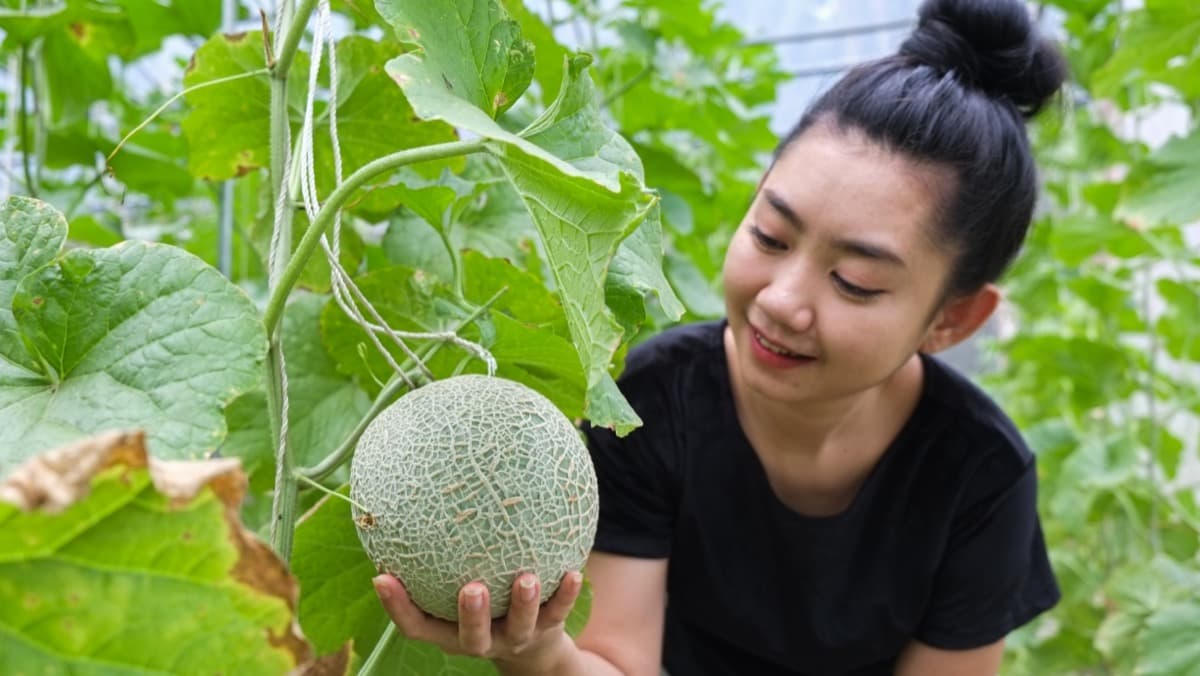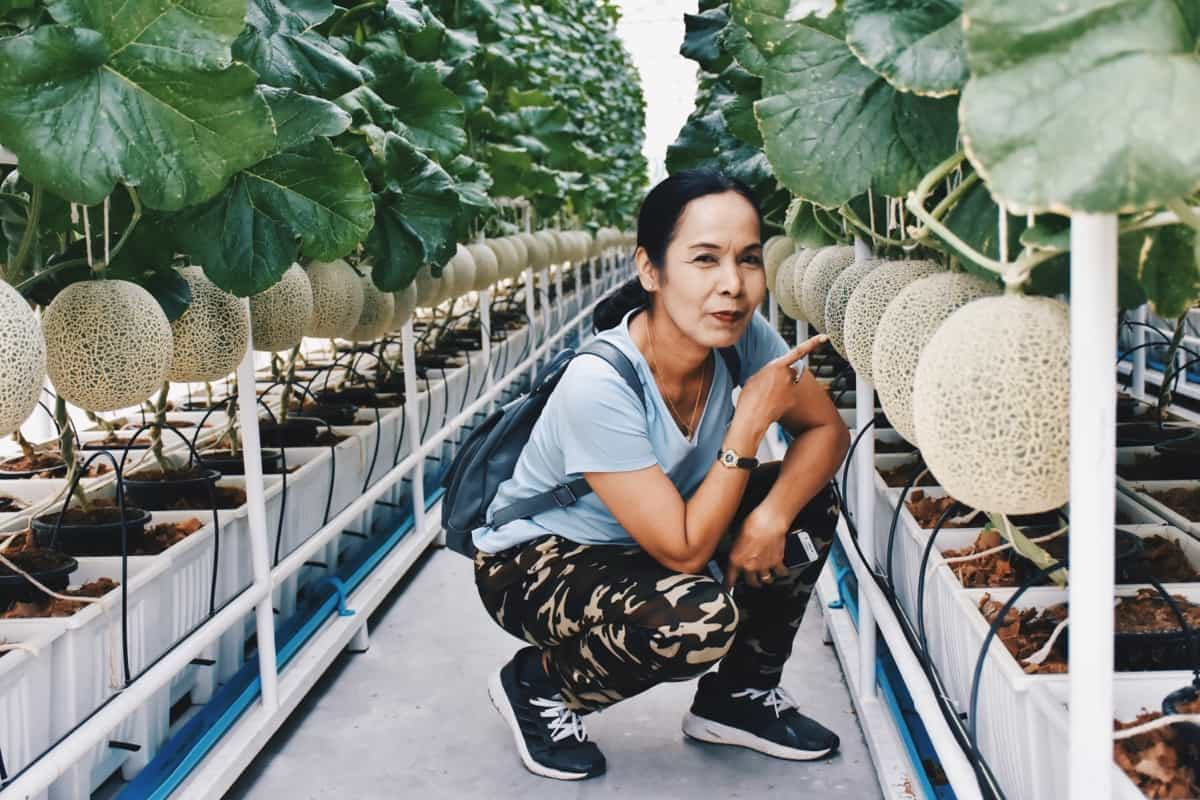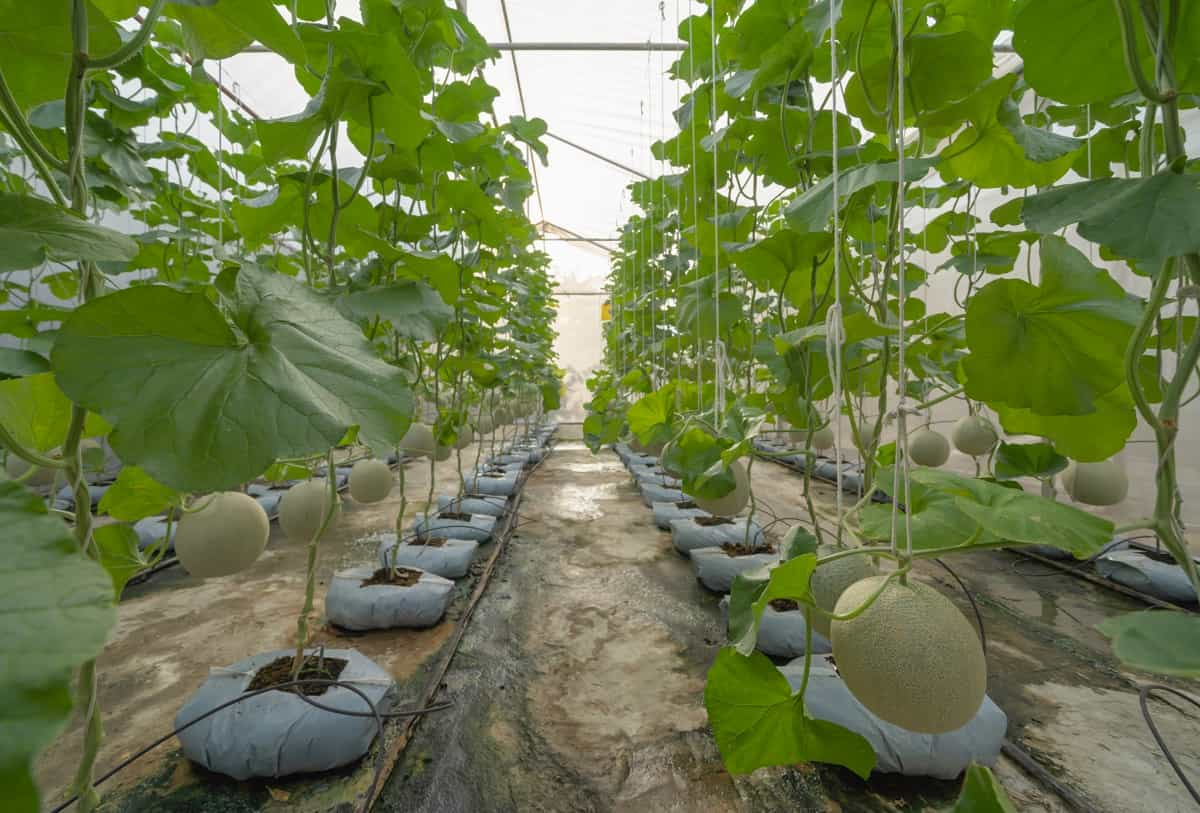Hydroponic farming is an innovative agricultural method that involves growing plants without soil by using nutrient-rich water solutions. This technique allows for precise control over growing conditions, improving crop yield and quality. One such crop that has shown great potential for hydroponic cultivation is cantaloupe, a popular fruit known for its sweet and refreshing taste. Below we learn about starting a hydroponic cantaloupe farm in a greenhouse from scratch, covering topics such as selecting the right hydroponic system, creating optimal growing conditions, and implementing effective maintenance practices.

Hydroponic Cantaloupe/Muskmelon Farming in a Greenhouse
Choosing the Right Hydroponic System
Nutrient Film Technique (NFT): In this system, a thin film of nutrient solution flows over the roots of plants, providing them with water, oxygen, and essential nutrients. The cantaloupe plants are typically supported by net pots or grow baskets placed in a sloped channel. NFT systems are suitable for smaller greenhouses and require less water and nutrients than other systems.
Aeroponics: This method involves regularly misting the plant roots with a nutrient-rich water solution. Cantaloupe plants can be grown in vertical towers, saving space and allowing for efficient resource use. Aeroponics is known for its high growth rates and disease resistance but can be more expensive and complex to set up and maintain.
Dutch Bucket: In this system, the plants are grown in individual containers or buckets filled with an inert growing medium like perlite or coconut coir. A drip irrigation system delivers the nutrient solution to the plant roots. Dutch Bucket systems are easy to set up and maintain and provide good support for the heavy fruiting cantaloupe plants.
Greenhouse Construction and Environment
- Size: Choose a greenhouse size that accommodates your desired production scale and fits your budget. Ensure enough space for the hydroponic system, storage, and working area.
- Orientation: Position your greenhouse in a location with optimal sunlight exposure, ideally facing south in the northern hemisphere and north in the southern hemisphere.
- Glazing Material: Select a material that provides good light transmission, insulation, and durability. Options include glass, polycarbonate, and polyethylene film.
- Ventilation: Proper ventilation is crucial for temperature and humidity control. Include vents, exhaust fans, and circulation fans in your greenhouse design.
- Heating and Cooling: Install heating systems like heaters or heat exchangers to maintain optimal temperatures during cold months, and use shading materials, evaporative cooling, or air conditioning systems for hot periods.
Creating Optimal Growing Conditions
- Temperature: The ideal temperature range for cantaloupe growth is 70-85°F (21-29°C) during the day and 60-70°F (15-21°C) at night. Avoid temperatures below 50°F (10°C) as it can stunt growth and cause fruit drop.
- Lighting: Cantaloupes need at least 12-14 hours of sunlight or artificial light daily for optimal growth and fruiting. Consider installing supplemental LED or high-intensity discharge (HID) grow lights if your greenhouse does not receive sufficient sunlight.
- Humidity: Maintain relative humidity levels between 50-70% in your greenhouse. High humidity can lead to fungal diseases, while low humidity can cause poor fruit set and slow plant growth. Use humidifiers or dehumidifiers as needed to regulate humidity levels.
- Nutrient Solution: Use a balanced hydroponic nutrient solution designed for fruiting crops, with an appropriate ratio of macronutrients and micronutrients. Monitor and adjust the pH and electrical conductivity (EC) of the nutrient solution regularly to ensure proper plant nutrient uptake. The optimal pH for cantaloupes is 5.8-6.2, and the recommended EC is 1.8-2.2 mS/cm.
In case you missed it: How to Grow Yellow Muskmelon from Seed: A Step-By-Step Guide

Planting and Support
- Seed selection: Choose high-quality, disease-resistant cantaloupe seeds from a reputable supplier. It is essential to use hybrid or self-pollinating varieties suitable for hydroponic cultivation.
- Germination and transplanting: Germinate the seeds in a sterile seed-starting medium or rockwool cubes. Transplant the seedlings into the hydroponic system when they have developed two to three true leaves.
- Plant spacing: Allow sufficient space between plants to ensure proper light penetration, air circulation, and room for growth. Generally, 2-3 feet (60-90 cm) between plants and 4-6 feet (120-180 cm) between rows is recommended.
- Trellising and pruning: Support your cantaloupe plants using trellises, stakes, or cages. Train the plants to grow vertically, removing any lateral branches and tendrils that do not produce fruit. Prune the plants regularly to maintain a single main stem and encourage fruit development.
Pollination and Fruit Set
Since most commercial greenhouses lack natural pollinators, manual pollination is necessary to ensure a successful fruit set. Use a small paintbrush or cotton swab to transfer pollen from the male flowers (with a thin stem) to the female flowers (with a small fruit at the base). Conduct pollination during the morning hours when the flowers are most receptive.
Pest and Disease Management
Hydroponic systems generally have fewer pest and disease issues compared to soil-based cultivation. However, monitoring your plants for any signs of infestation or infection is crucial. Implement an integrated pest management (IPM) strategy that combines biological, cultural, and chemical methods to control pests and diseases. Use natural predators like ladybugs and lacewings to control aphids, and apply organic fungicides to prevent powdery mildew and other fungal diseases.
Harvesting and Storage
Cantaloupes are ready for harvest when the fruit has a full netting pattern, a slight depression at the blossom end, and a sweet aroma. To remove the fruit from the vine, cut it with a sharp knife or a pair of pruning shears, being sure to keep a little piece of the stem connected. Store the harvested cantaloupes in a cool, dry place with a temperature of 45-50°F (7-10°C) and a relative humidity of 85-90%.
In case you missed it: How to Grow Muskmelon/Cantaloupe in Greenhouse: A Step-By-Step Guide for Seed to Harvest

Conclusion
Starting a hydroponic cantaloupe farm in a greenhouse from scratch may seem daunting. Still, following the key rules outlined in this article can create a thriving and productive operation. From selecting the right hydroponic system and designing an effective greenhouse to maintaining optimal growing conditions and implementing sound management practices, your hydroponic cantaloupe farm can become a successful and rewarding venture.
- Feed Your Flock for Less: Top 10 Tips to Save on Chicken Feed
- Ultimate Guide to Ossabaw Island Hog: Breeding, Raising, Diet, and Care
- Hatching Answers: The Top 10 Reasons Your Chickens Aren’t Laying Eggs
- Eggs and Economics: Breaking Down the Cost of Raising Backyard Chickens
- Defend Your Greens: Proven Methods to Keep Iguanas Out of Your Garden
- Ultimate Guide to Cinnamon Queen Chicken: A Comprehensive Guide for Beginners
- Ultimate Guide to California Tan Chicken: Breeding, Raising, Diet, Egg-Production and Care
- Ultimate Guide to Marsh Daisy Chicken: Breeding, Raising, Diet, and Care
- 10 Types of Chicken Farming Businesses You Can Start for Profits